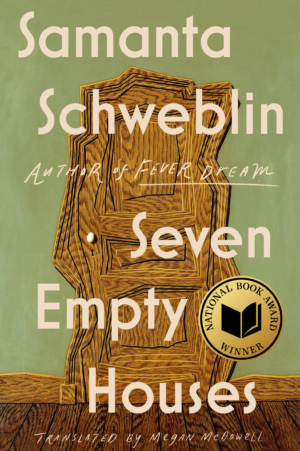Seven Empty Houses
by Samanta Schweblin, translated by Megan McDowell
reviewed by Gabriella Martin
The homes in Seven Empty Houses, the latest short story collection by Argentine author Samanta Schweblin to appear in English, are not ones you’d want to return to for the holidays. The houses are not literally empty but are, rather, inhabited by people—usually women—grappling with emptiness in various forms. In Schweblin’s twisted world, the domestic is distorted, off-kilter, unheimlich: uncanny, and in the word’s more literal translation, deeply “unhomely.” Sure, some of these homes have Christmas trees, but on their branches there are “six Santa Claus figures dangling [ … ] like a club of hanged men.”
These dark spaces will come as no surprise to readers familiar with Schweblin, one of the most masterful Latin American writers working today. Seven Empty Houses, translated by Schweblin’s consistent collaborator, Megan McDowell, won the 2022 National Book Award for Translated Literature, which may also come as no surprise; Schweblin, in McDowell’s translations, has thrice been nominated for the International Booker Prize (for the novels Fever Dream and Little Eyes, and the story collection Mouthful of Birds). McDowell is also responsible for bringing the authors Mariana Enríquez, Alejandro Zambra, and Paulina Flores (among others) to readers of English, acting as one of the most prolific and talented translators of contemporary Latin American literature. Together, Schweblin and McDowell are the definition of an author–translator power duo.
Seven Empty Houses is characterized by the disorientation typical of Schweblin’s writing—think Fever Dream, both the 2017 book and the feverish confusion the reader feels while engaging with the text. While the stories in Schweblin’s first collection to appear in English, Mouthful of Birds, verged on the fantastical, the stories of Seven Empty Houses are lodged within a recognizable reality, albeit one distorted by madness, grief, and above all, loss. The result is a surrealist reality that looks like our own, but slightly bent, and because of that, is all the more eerie in its plausibility. These things don’t really happen, but they technically could.
That fever dream (or perhaps, fever nightmare) feel is present in all the stories, but particularly in the first, “None of That,” in which a daughter drives her mother around to “look at houses,” an activity that, like most in this collection, goes unexplained at first, its meaning coming to be revealed bit by bit. Their car gets stuck in the mud outside a wealthy woman’s home, which the mother enters, rifles through, tidies, and steals a sugar bowl from, later to bury in her own backyard. The mood of the story is one of discord and dread, like a dream where you’re stuck in place or running in circles and everything has gone terribly wrong.
Seven Empty Houses presents variations on the theme of home, refracted through different, troubling prisms. Many motifs (ambulances, fences between homes, boxes of objects, discarded clothing, lost sons, rotisserie chickens, fainting spells, voids) overlap and reappear in different forms throughout the collection. The stories are interconnected not by plotlines or characters (or, at least, not explicitly so), but by images, moods, objects. For example, one story in which a narrator’s “parents are running naked in the backyard” is followed by another story, with a totally different yard, where “there they are again, all those clothes scattered over the grass,” tossed there by a grief-ridden neighbor. We can imagine a warped neighborhood where these characters somehow coincide, as if Schweblin has shuffled a deck of images and laid them out differently for each story.
The most salient undercurrent in the collection, however, is a meditation on the concept of lack. One of the most significant reasons for such a lack is children, gone missing—either for the day, as in “An Unlucky Man,” in which a predator lures a child into a department store to buy new underwear, or permanently, as in “It Happens All the Time in this House,” in which a mother copes with the death of her son. Other stories have objects—or even characters—go missing, both existentially and physically, like in “Two Square Feet,” when, sent out into the night to buy aspirin in an unfamiliar city, a woman descends into disorientation and dread, reeling from a confession her mother-in-law has just made to her about almost leaving her family years ago. We are left wondering if the women ever returns to her own family.
Just as the characters in each story confront lack, we too, as readers, are left without many details. The prose is sparse; Schweblin gives us very little information, trapping us within a character’s limited perspective and then asking us to work to fill in the gaps. This is achieved most successfully in “Breath from the Depths,” more of a novella than a story, which allows us to spend a considerable amount of time with Lola, who is spiraling (presumably) into dementia and longs to die, but “was starting to fear the worst: that death required an effort she could no longer make.” She obsessively boxes up possessions, keeps a list of essential rules in her pocket, and repeatedly forgets that the neighbor’s son has died—and we have no choice but to live within her mind, her rules, her madness.
This is the ultimate terror and joy of reading Schweblin, though: her mind, her rules, her madness.
Published on January 3, 2023

